Tricky, but ultimately not as tough as I expected.
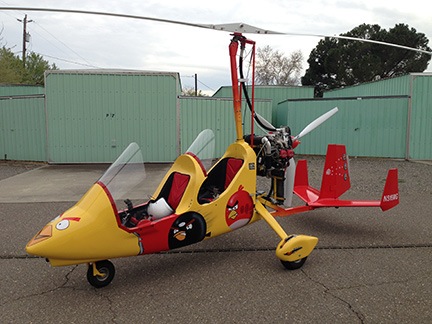
George’s angry bird, a Magni M-16 gyroplane.
Earlier this month, I learned to fly a gyroplane.
It actually came about quite suddenly. My friend George owns a Magni M-16 gyroplane. It’s a funky little plane with an Angry Birds themed paint job. (In George’s defense, he bought it that way.)
I met George when he was at the airport where I was living for my frost contract in the Sacramento area. He was teaching another pilot, Jason, how to fly his angry bird. George took me for a ride that demonstrated the full range of the aircraft: low flight, slow flight, power-off flight, long landings, short landings, etc. It was a lot of fun.

Who paints this on a plane? Too fun!
And a hell of a lot cheaper to fly than my R44 helicopter.
George is a CFI with multiple ratings: gyro, airplane, and helicopter. When I voiced some interest in learning to fly the gyro — hell, I didn’t have any real work to do during the day — we cut a deal to swap a certain amount of gyro time for a certain amount of helicopter time.
Then George went to Alaska to teach a 17-year-old kid how to fly a Piper Cub. He didn’t provide a return date. And when a week had passed and my California departure date appeared on the current calendar page, I figured I’d missed my opportunity.
Until I got a text message from George with an arrival time at Sacramento Airport and a request for a pickup. I met him on Sunday and brought him to the airport where I was living to fetch his car. Flight training began the next day.
Understand that I’m a helicopter pilot. I have about 3,100 hours of flight time as I type this. Just about all of my time is in R44, R22, and B206L helicopters. I don’t fly airplanes.
Although my wasband had a plane and offered me the controls on more than one occasion, I had absolutely no interest in flying it. It was a get-there plane — a plane designed to get from point A to point B. That’s not the kind of flying I like to do. I like to fly low and slow and see the world around me. If he had a Cub or a Citabria, especially if it had big tires for off-airport landings, things might have been different. But it was a Grumman Tiger, a pampered hangar queen that likely never saw a gravel runway or cruised just above stall speed through a canyon.
To me, getting there was not the point of flying. The journey mattered more than the destination. That’s why I became a helicopter pilot.
I learned to fly an autogyro or gyroplane. These terms are pretty much interchangeable. Gyrocopter, however, is a trademark of the Bensen Aircraft company. Gyro is a good general use term that, for some reason, doesn’t sound as antiquated as autogyro.
Like helicopters, gyros are categorized by the FAA as rotorcraft. After all, they do have those big rotor blades on top that provide lift. But unlike helicopters, those rotor blades are not driven by the engine. Sure, you use a clutch to get the blades spinning prior to takeoff. But then you disengage the clutch and the blades are kept spinning by the forward motion of the aircraft, which is propelled, in the case of the Magni, by a pusher engine. You can learn more about how gyros fly on Wikipedia.
First Lesson
George started by getting me into the pilot seat, explaining how everything worked, climbing into the passenger seat behind me (which has controls but no instruments), and taxiing out to the runway. The weather that Monday morning was perfect — clear blue skies and no wind — perfect for learning to fly any aircraft. There was no traffic in the pattern. I couldn’t ask for better learning conditions.
At the end of the runway, he explained how to engage the clutch to get the blades spinning. At 100 RPM, I moved the cyclic stick into a neutral position. As the blades spun up, I added power. At about 170 RPM, I released the parking break, and we entered the runway.
“Full throttle!” George’s voice yelled into my headset.
I pushed the throttle forward and we gained speed as George aimed us down the runway.
“Release the clutch at 220!”
I consulted the digital tachometer and I released the clutch on cue. The blades kept gaining speed.
“Cyclic back!”
This was completely opposite to taking off with a helicopter, which requires you to push forward to get through ETL. I pulled it back a bit.
“All the way back!” George yelled.
I obeyed and the nose lifted off. Then we were airborne, wiggling a bit from side to side.
“Hold it at 60!” I did my best to adjust our pitch with the cyclic to climb out at 60 miles per hour. We climbed upwind.
“Turn!”
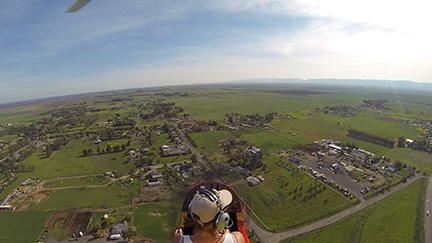
Flying the downwind leg at Watts-Woodland Airport.
Right cyclic put me into a tight bank to the right. I came all the way around into a close downwind.
“Level off at 500 feet!”
I leveled the nose abeam midfield. We gained speed.
“Throttle back!”
I pulled the throttle back a bit.
“Twenty-nine inches!” George advised.
I adjusted the throttle to 29 inches of manifold pressure. The speed leveled off at about 85 miles per hour. By then, we were abeam the end of the runway and it was time to descend. I reduced the throttle and started my descent, slowing down as I did so. After all, that’s how helicopters descend.
“Stick forward, stick forward!” George yelled.
I pushed the nose forward into what seemed like a dive.
“Reduce throttle!”
I pulled back the throttle to about 25 inches. I pushed the cyclic right to turn base and line up with the runway for final, pulling back the stick again to slow down.
“Nose down, nose down!” George screamed.
I felt him push the stick forward. We were speeding toward the runway in what seemed to me like a nosedive.
“Cut throttle!” he yelled.
Before I could do it, he’d throttled all the way back to the lowest power setting. We were diving for the runway with no power. We crossed the road only 50 feet above passing cars.
“Line up with the centerline!”
I tried to line us up with the centerline, using the cyclic stick.
“Left pedal! Right cyclic! Nose down!
I was overwhelmed. The runway was rushing up toward us. Once again, I tried to flare.
“Not yet!” George yelled, pushing the stick forward again. “Five feet!”
I felt his firm grip on the controls as we continued to dive, now over the threshold. Right when I thought it was too late, he pulled the stick back gently, bringing the gyro into level flight over the numbers.
“Let it settle!” he yelled.
We drifted down toward the ground, still moving at at least 60 miles per hour.
“Okay, now flare!”
He pulled the stick back some more, bringing the nose up so we’d touch down on the main gear. Then the nose wheel touched and we were on the ground.
“Full throttle, full throttle!”
I didn’t get a chance to enjoy that landing before we were speeding down the runway again.
So this was the “touch and go” that airplane pilots practiced all the time. Despite the rotors spinning over my head, this was all new to me.
Training Continues
Each traffic pattern we did went pretty much the same. We were turning them in about two minutes. This video from the afternoon of the second day gives you a (shaky) idea of the process.
My two biggest problems were pulling the cyclic back on takeoff and pushing it forward on landing. Both were completely opposite to what I do in a helicopter. What I’d been doing for 3,100 hours of flight time. It wouldn’t be easy to break those muscle memory habits.
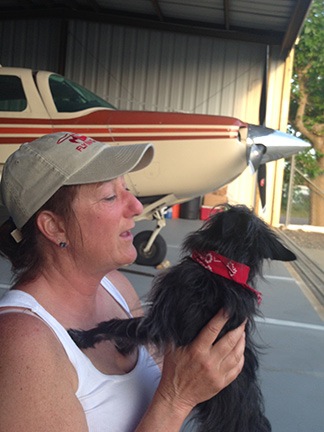
Penny and I relaxing at George’s hangar between flights. That’s George’s Mooney behind us.
My landings proved to be the biggest problem. You see, gyros can’t hover. (Well, they can hover if they’re in a strong enough headwind, but then again, so can an airplane.) They require forward speed to take off and land. And that’s where I was having the most trouble — landing while I was still moving. Remember, I’m a helicopter pilot and I’m generally not moving in any direction when I touch down on the ground. I wanted to flare, I wanted to bring the aircraft into a hover or at least slow down that forward movement before touching the ground. And I simply couldn’t stop myself from pulling the stick back.
We did a thorough preflight before the second flight on Monday. I learned what everything was, what it does, and how to check it for airworthiness.
We flew 2 hours on Monday, 2 hours on Tuesday, and 1.6 hours on Wednesday. The weather cooperated perfectly.
We took the helicopter to lunch on Monday to Nut Tree Airport and Wednesday to Sacramento Executive Airport. George flew. I even let him sit in the right seat. He was a good pilot and, even though I had the duals in, I felt no inclination to touch the controls. It was great to be a passenger in my own helicopter with a skilled, confident pilot at the controls.
Frustration and Breakthrough
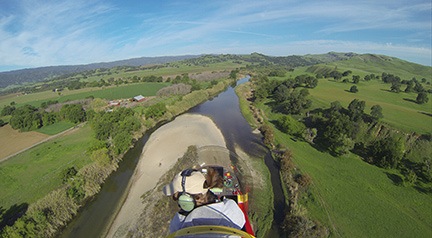

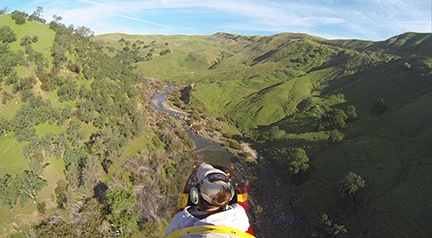

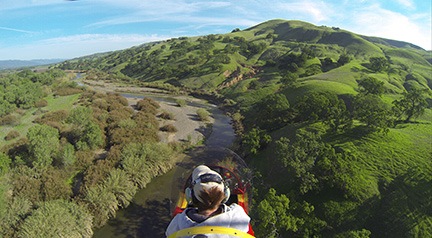
Some random still images from our gyro flight up Cache Creek. These are not cropped or retouched other than being resized for the web; it really was that green. I repeated the flight on Friday with my helicopter and got some stunning video.
Wednesday morning, we took a break from traffic patterns and did a low-level flight up Cache Creek with the GoPro connected. The video is as shaky as above, but still shots from the flight came out pretty good. Then it was back to the airport for more pattern work.
Wednesday is also when we made the breakthrough. I was flying like shit that afternoon and George was at peak frustration. I just couldn’t get the landings right, mostly because he kept yelling so many instructions at me during the last 15 seconds of each flight: left cyclic, right pedal, nose down, watch your airspeed, right cyclic, left pedal, watch the centerline, nose down. The rapid fire commands were overwhelming me and my brain was shutting down.
After one particularly rough landing, George called it quits for the day. As we taxied back to the hangars, letting the rotor blades spin down, he suggested that maybe I just wasn’t going to get it.
Later, over dinner, I asked him whether I was the first helicopter-only pilot he’d trained. When he realized that I was, that all of his other students had been airplane pilots, he started to understand my problem. Gyros landed like airplanes and I simply didn’t know how to land an airplane.
I asked him to stop yelling so many commands at landing. I told him my main problem was knowing when to flare and asked him to concentrate on instruction for that.
The next day, he had some things to attend to in the morning and then had lunch with another pilot. When we taxied out to the runway in the gyro, I reminded him about what I needed. We took off and started pattern work again.
It was different that afternoon. George stayed mostly quiet, letting me do everything and occasionally commenting on my speed or power setting or other aspect of the pattern flight. He even threw out a few words of praise when I made a descent he liked or set the power just right. He focused his instruction on the proper time and amount to flare for landing — rather than also bugging me about the centerline and staying in trim. There was no yelling.
I relaxed. I got us lined up with the centerline. I kept us in trim. And I was able to make one decent landing after another. I had gotten over the hump. I was proving that I got it by demonstrating that I could do it on my own.
We flew for an hour. George was pleased. Later, at dinner, as he was updating my log book, he debated whether he should sign me off for solo flight. But I think he wanted me to solo in his aircraft with a few more takeoffs and landings right before the solo flight. So he held back on the endorsement.
The next day, Friday, I had business in San Francisco. I was visiting a friend that I’d met seven years before online and had never met in person. We were going for a dim sum lunch just off Market Street. I planned to fly the helicopter to Concord by way of Napa Valley and walk to the BART station, dropping Penny off for grooming and doggie day care along the way. A quick train ride into San Francisco, time spent with an old new friend, some shopping, and then a return to Woodland. The day went off as planned, but I didn’t get in until after 5 PM and I was exhausted after walking more than 5 miles on city streets.
George and I had dinner together when I got in. He came back to the mobile mansion to watch the video I’d shot with my GoPro’s nose mount. We tried to figure out why that video was rock solid while the video from the same camera mounted on his gyro’s mast was so shaky.
Solo Flight
Saturday morning, we headed out for another lesson. George was pretty quiet. I flew. When I made my third landing and began to throttle up, he pulled the throttle back.
“I’m going to get out,” he said.
I realized that solo time had come. “One more,” I begged. I pushed the throttle forward and I made yet another good takeoff, pattern, and landing. There was no excuse to put it off any longer. I taxied off the runway to the intersection and let the blades spin to a stop. George got out.
“Are you going to watch?” I asked.
“I’ll probably head back to the hangar,” he replied.
I taxied away, trying to remember everything I needed to know to spin up the blades, take off, do a pattern, and land. I was expected to do three patterns.
I made my radio call and launched down the runway. The gyro responded quite differently with just one person onboard, shooting into the sky quicker and easier than I thought possible. It wasn’t until the second pattern that I figured out how to set the power properly for solo flight.
I was high and hot when it came time for the first landing. I really did dive for the runway, cutting power to just above idle when I was over the road. Down, down, down — I caught myself pulling back on the stick and pushed forward again. I could see George still standing where I’d left him, watching me as I touched down remarkably smoothly. Then full throttle to take off for the second trip around the pattern.
The second landing was a bit rougher, but certainly acceptable. I’ll do better on the next, I told myself. And I did. I touched down lightly, right in the middle of the runway, at what seemed like a jogging pace. So slow, in fact, that I was able to exit the runway at the first turn.
I taxied toward where George was still waiting and he snapped a photo.
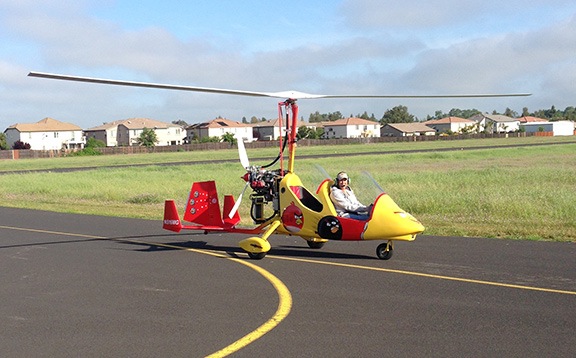
George snapped this photo of me as I taxied off the runway after my first solo flight.
I’d soloed in a gyro after just 7 hours of training.
Ready for Rating
Because the gyro is a light sport aircraft and because I already have a rating for another aircraft in the same category (rotorcraft category, helicopter class), George says I can get a sport pilot rating for the gyro by taking a check ride with another gyro CFI. The trick is to find one of those. In the meantime, since George flew the helicopter down to San Carlos and back with me later that day, he owes me another 2 hours (or so) in the gyro. So I’ll need to come back to California to collect on that debt — if not in May, then perhaps in August or September. (With luck, I’ll overfly it and owe him some more helicopter time so he’ll have to come up and visit me to even things out.)
In general, George was a great instructor. Why? Because he barely touched the controls at all. He yelled instructions and I followed them to the best of my ability. He’d let me get in trouble and then yell commands for me to follow to get out of trouble. The only time I ever felt his hands on the controls was when I was in trouble so deep that I needed help getting out of it. And that was rare after our first two hours of training.
As for my outlook on fixed wing aircraft — well, that’s changed a bit. Now that I know how to land while I’m still moving, airplanes are a tiny bit more interesting to me. But what’s really interesting is this little bird. Maybe I’ll add a seaplane rating someday soon.
Discover more from An Eclectic Mind
Subscribe to get the latest posts sent to your email.

Maria, you make me sound like some kind of ogre! I didn’t yell that much did I?
It was well written and informative. I’m impressed.
The two hours owed
are good indefinitely.
Did I? Hell, I thought I toned it down! Ha! I think most of the yelling was because I just couldn’t hear you over the noise of the open cockpit.
I really enjoyed that story and the video.
You capture the excitement of those steep approaches very well.
I came to gyros via a fixed wing licence so hitting the the ground running seemed normal. My gyro time was on MT03 which looks pretty much like your CFI’s Magni.
I loved having my head out there in the elements, like motorcycling, but the downside of open cockpit is that monitoring the radio is much harder.
I have a few helio hours (R22) and would say that the 22 is far more sensitive to control than a gyro. Each has its own quirks. At least a helicopter avoids the pitfalls of cross-wind landings.
I really enjoyed the open cockpit gyro. If George lived around here with his machine, I’d likely beg him to become a part owner so I could fly it all the time.
I agree.
My main hours, and only qualification, are(is?) on very small fixed wing A/C such as C152/172. I would love a heli certificate but even the R22 was too expensive for a weekend hobby pilot like me. I did a dozen fun hours, all I could afford.
Yet I have had my best fun on Gyros. That said, the weather for my course was perfect, which is rare for the UK. C-180 on floats in Canada, was another amazing experience. Only money got in the way.
I find the attitude of the instructor is all important. The first guy who taught me basic flying was a mega-hours BA 747 captain who wanted to inspire others with a love of flight. He pretended to sleep unless I got things wrong. Then he would wake up to bark at me.
The best ‘natural pilot’ I ever knew was a high hours basic AFI with no hope of an airline job because he looked so odd. (Ian, if you ever read this, you were an outstanding and inspiring tutor pilot)
But there are so many obstacles to a career in flying that have nothing to do with competence or piloting genius.
Maria, you are obviously a good safe pilot. Without having met you I just know that you would bring us back alive.
But not all the great pilots were safe.
Erich Hartmann, the best fighter ace ever, for sure, crashed frequently, he messed-up his first solo, too.
In Vietnam, R. Mason ( author of ‘Chickenhawk’) used his wide-blade Huey as a brush-cutter to create landing zones. Not in the manual, not safe, but do-able.
I read Chickenhawk. It was a very enlightening read. And I do agree — your instructor makes a huge difference in not only your flight skills, but your attitude and approach to flying. Mine were, for the most part, very good; for a brief time I had a bad one but I left that school when I realized he was wrong for me and there was no possibility have having him changed.
Glad you liked ‘Chickenhawk’. There are moments in Robert Mason’s book that stay with you forever. Like hovering six inches over a minefield within 2,000 lbs of high explosive missiles on board, unable to go back and with a tall fence in front, as rotor rpm gradually decays every time he attempts to raise the collective…
That book has so much flying detail the reader comes away believing they could fly his Huey straight off the page. Great stuff.
Yes, that’s the scene I remember most, too. Very visual.